Howdy, Stranger!
It looks like you're new here. If you want to get involved, click one of these buttons!
Quick Links
Why CAC is Always a Good Second (or Third) Opinion
There was quite a lengthy thread over at PCGS about this coin, but I'd like to post it here too.
This is a very very rare coin (1 of 3 in existence), in this holder. Unfortunately, it's an altered proof, and has had the "cameo" applied to it's surfaces.
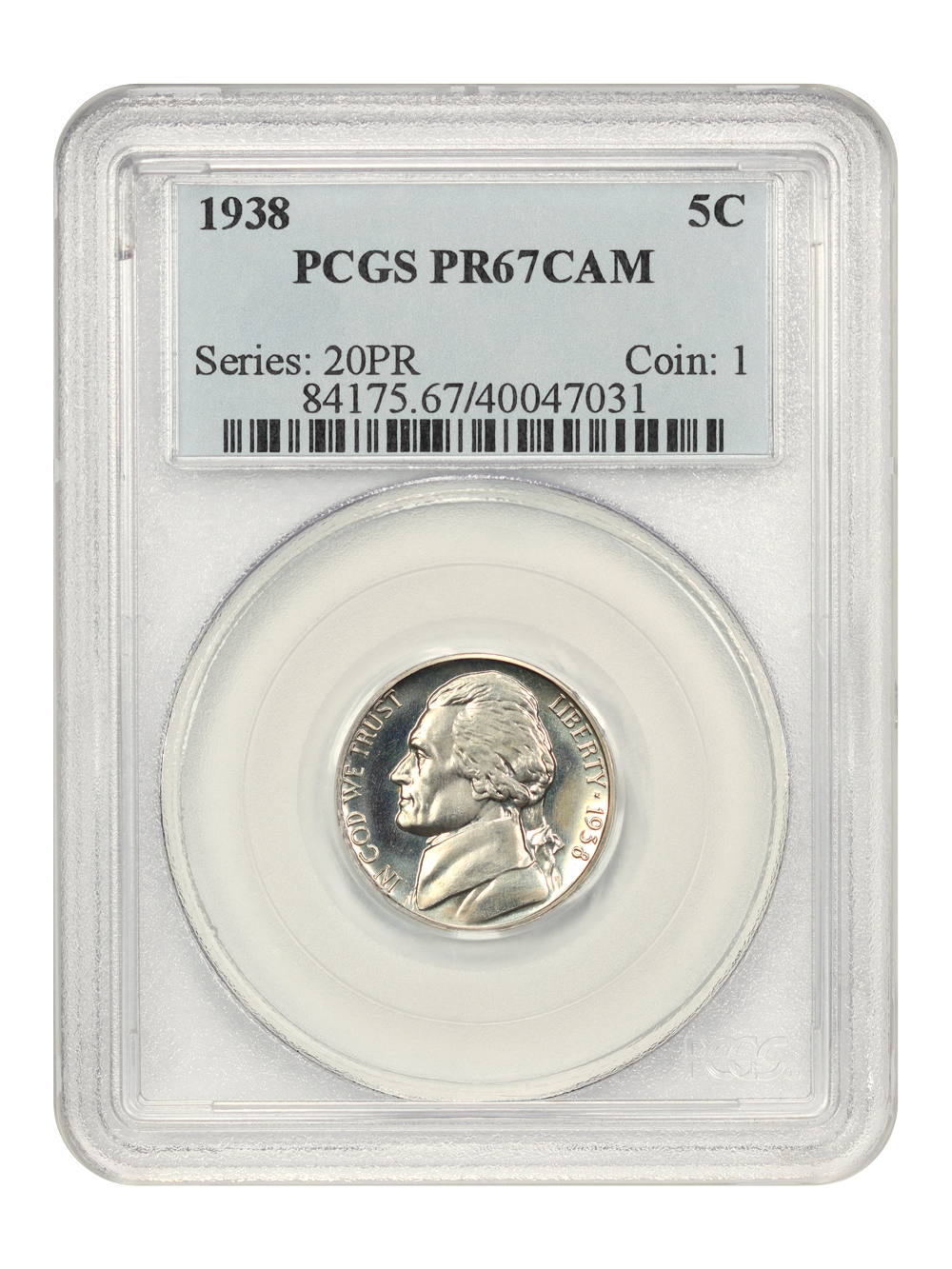
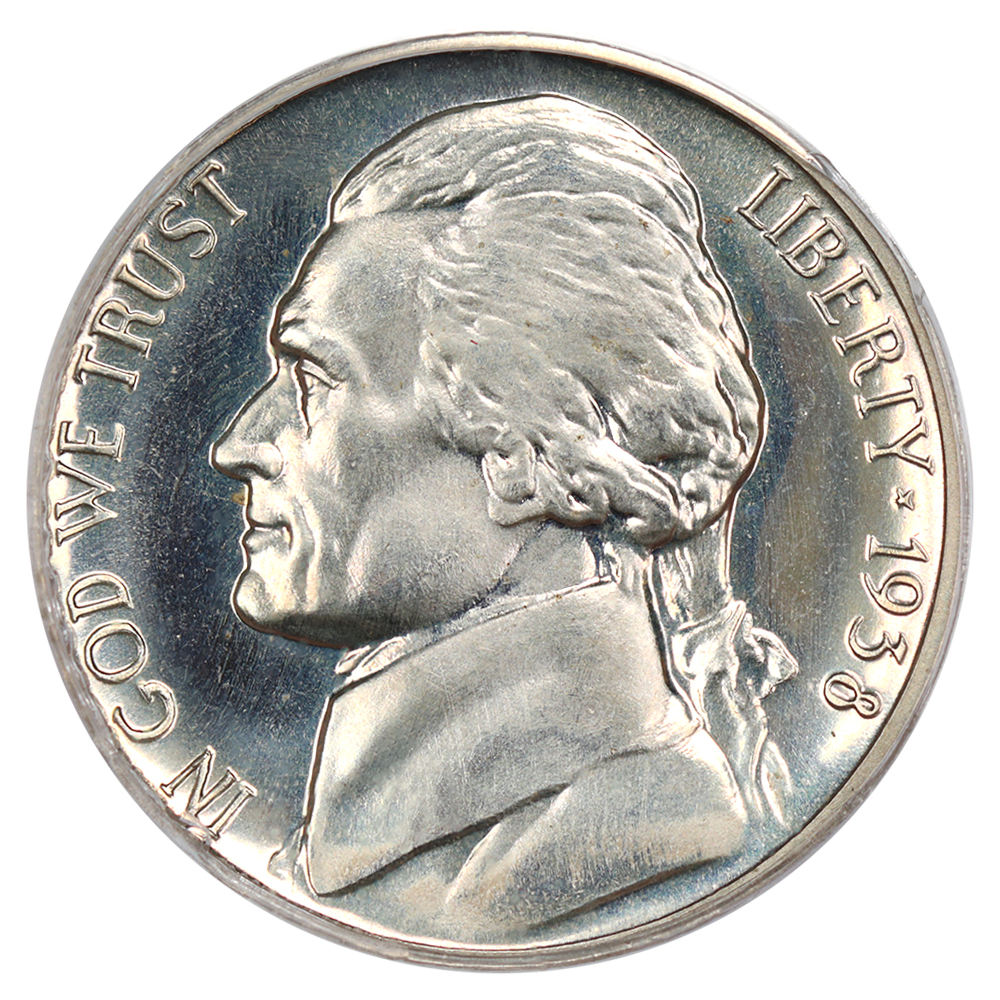
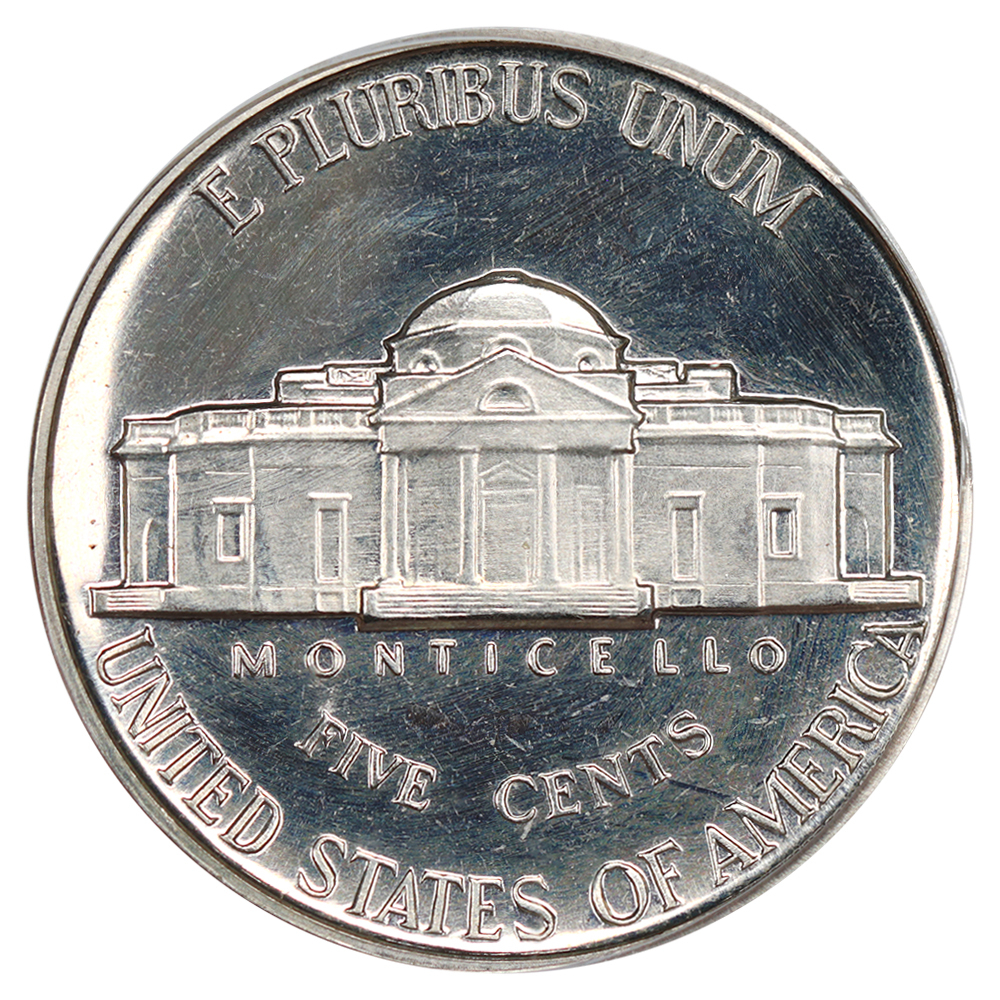
Here's the real story behind the coin. This coin was certified in the early 2000s, and was suspected a little bit around that time until 2005 or so when it disappeared. No one said much to anyone about it, just some minor grumblings.
This is exactly my kind of coin, and one I have years of experience with. To me, this coin just looks wrong, and if you know what to look for, you'll see why. When I saw it, I noticed almost immediately something was off, and I did a few mental checks. Sure enough, everything added up for an altered proof (and then I did some research to prove it). I immediately got in contact with the auction company and provided them with my evidence and suggested they remove the coin from auction and send it to PCGS. They went though the process of getting an appearance review done with PCGS. We won that appearance review today.
Today, if you looked up the cert number for that 1938 CAM nickel you'd get the following result:
PR GENUINE - UNC Details (94- Altered Surf.).
Here's my detailed analysis of the coin:
"This is an in depth analysis of why I believe the following 1938 PCGS PR67CAM nickel (cert # 40047031) is in fact an altered coin. There are four main points to focus on for this coin, and all are very concerning. Each one of these points relates to why I believe that this coin has had an artificial frost applied to the devices of the coin, likely a putty of some sort. This creates a hard to identify and somewhat realistic alteration that can fool all but those who know what to look for. For a brief background, this alteration is done when a coin doctor takes a brilliant proof and applies a putty or other substance to the devices of the coin, leaving the mirrored fields untouched. This creates the visual appearance of a cameo proof without the coin actually being a cameo proof. Many of these coins got past PCGS in the early 2000s, and this appears to be one such coin.
The first point relates to what I call “die matching.” This is an excellent way to confirm the authenticity of a cameo proof from this era, as it can confirm placement of the frost and the amount of contrast. This is done by comparing the present coin to known other cameo proofs or near cameo proofs from auction listings or CoinFacts. This is the only case I have come across where the coin cannot be matched to another cameo proof or near cameo proof. This is because no other coin from this die pair shows noticeable cameo contrast. This is especially strange because the “frost” is especially high quality on this coin and one would expect more than a few proofs showing noticeable contrast from the same dies to pop up. However, this is not the case. All other cameo proofs and near cameo proofs come back to a different die pair than this coin - the FS-402/unknown reverse pair. This coin is from the FS-403/unknown reverse pair and is the only known contrasted coin from this pair. All other coins from this die pair show brilliant devices. This strongly suggests that this coin is most likely altered, and this is exactly what I would expect for this type of alteration. A coin doctor would take a cheap brilliant proof and turn it into a “cameo,” pocketing the substantial profit off of an unknowing collector.
The second point relates to interesting “frost” placement. When viewing genuine cameo examples from this era, one quickly notices that the high points have the most frost, and the points of relief closest to the field are the areas with the least frost. This is due to the die production process - when new dies were produced they retained their satin frost from the hubbing and acid cleanup process. This was only removed when dies were polished or worn down during striking. The polishing process usually wore away the low point satin frost detail, and in many cases the high point detail as well. In some rare cases, however, the majority of frost was not worn away. This resulted in a cameo proof. These coins often show strongly frosted high point detail, and lightly frosted or brilliant low point detail from where the die was polished - again, the low point detail being closest to the fields was the first detail to be removed. On this coin, we see the opposite effect taking place - the high point detail lacks “frost” (Jefferson’s jawline and some of Monticello’s walls), but the low points show “frost” (Jefferson’s hair and the walls closest to the fields). These areas lacking “frost” seem to strongly correlate to where a brush could not reach, rather than where a die would be polished during die production. In addition, dies generally wore their frost away evenly during the striking process, conforming to the average surface of the planchets used. This produced an even loss of the original satin surface of the dies, creating an even wear pattern of the cameo surface.
The die wear was never splotchy or spotted as we see on this coin (see images of reverse splotches which are circled as high point brilliance), which again points to this coin being altered.
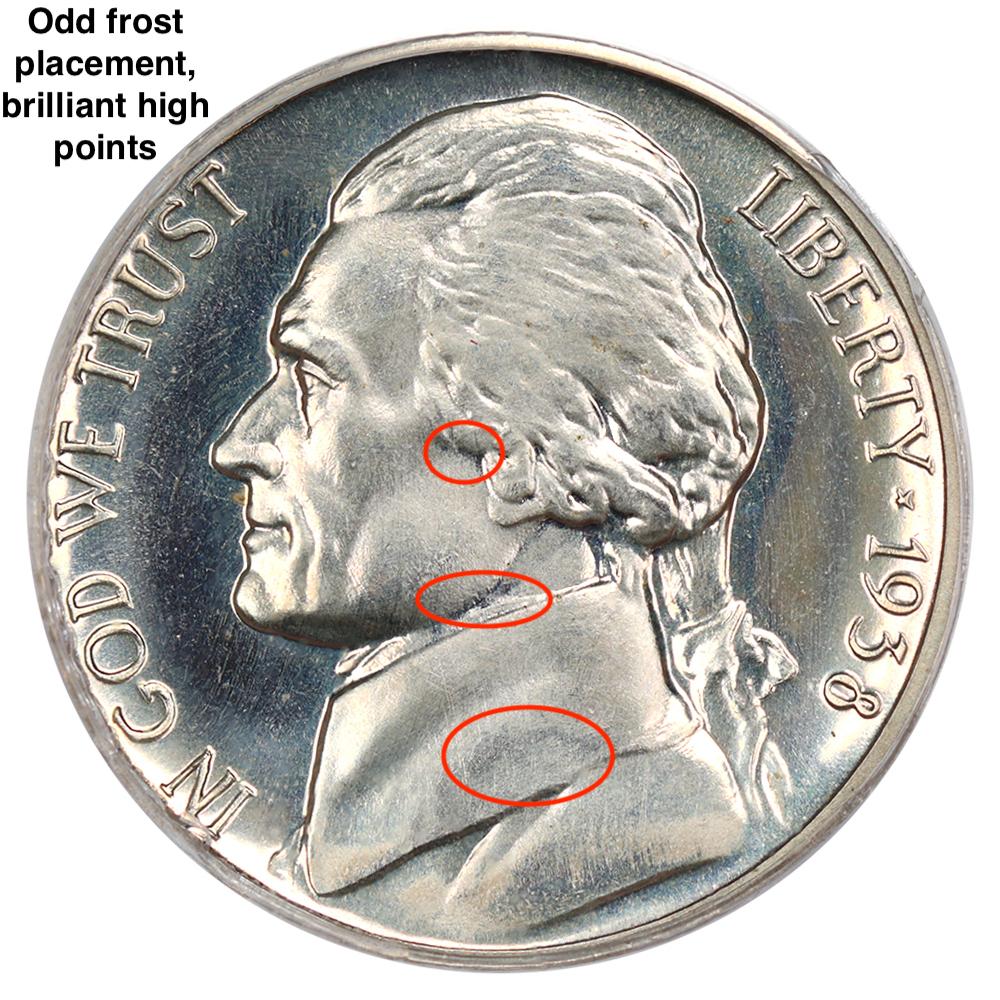
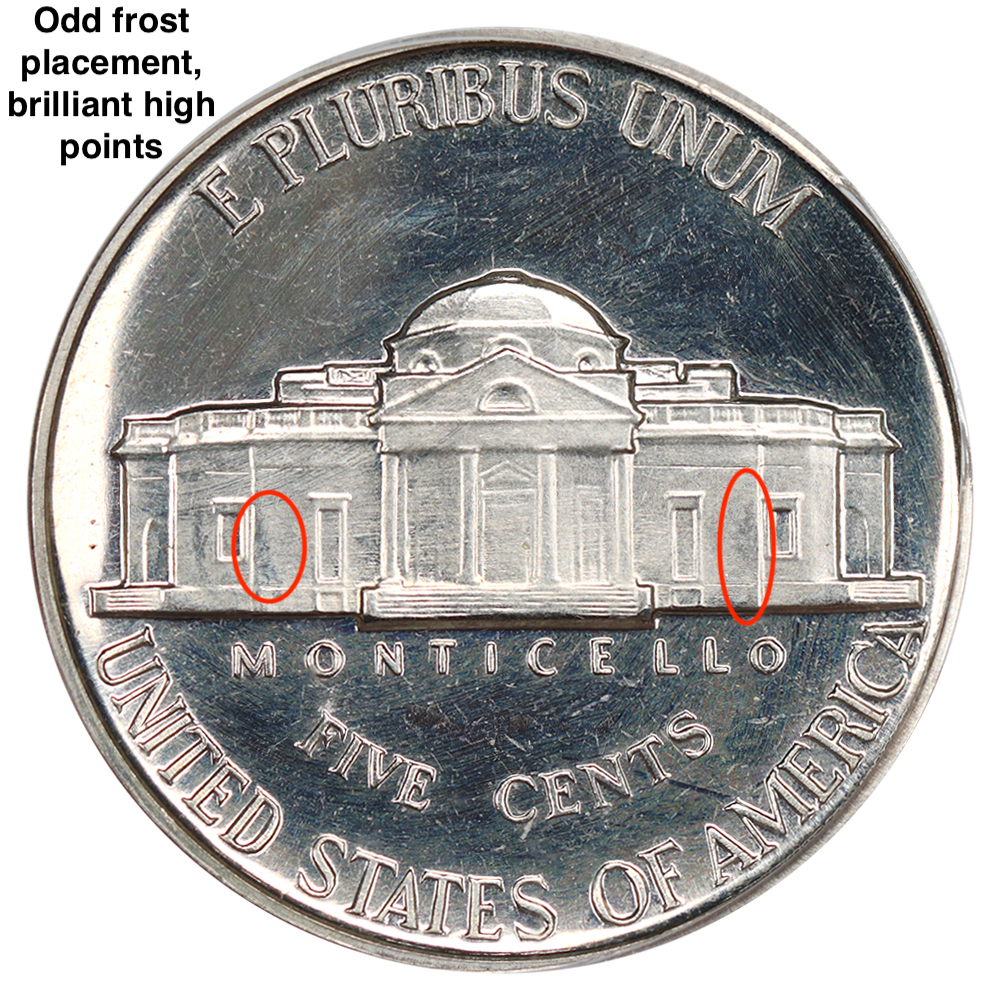
The third point relates to the brilliant brush lines observed on the reverse. These lines do not appear on any other proof that I have seen, and there is no logical way this was created at the mint. There was no process of brushing the dies with acid (they were dipped), and there was no post strike treatment for finished pieces. I believe the only explanation for this phenomenon is that the coin is altered. In addition, this is the most obvious and indicative feature of an applied frost alteration.
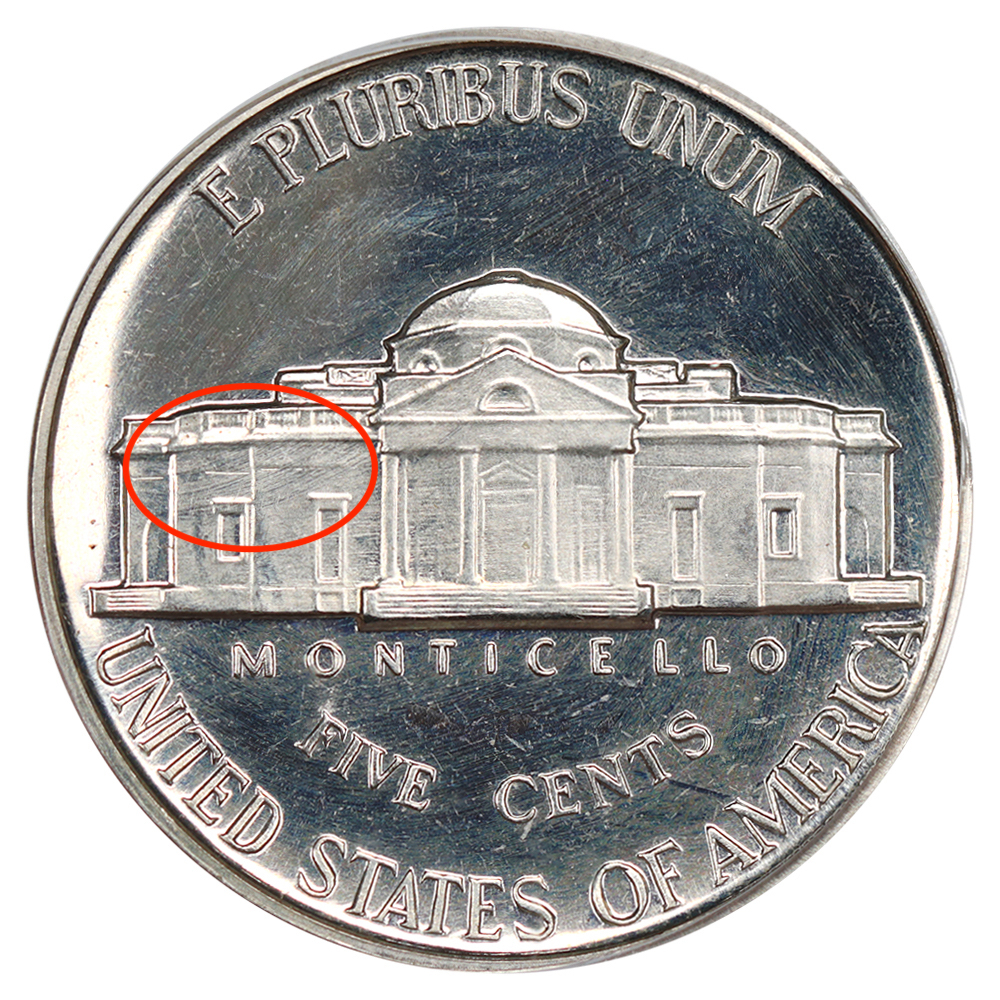
The last point relates to the overall look of the coin. This is the most subjective opinion of this analysis and is the least based on fact. However, in my experience, the frost on 1936-42 cameo coins is very distinct. It has a rough texture with slight areas of brilliance visible under high magnification. This is due to the frost being created by millions of minute die depressions during the final cleanup and acid dipping of a die before polish. In contrast, when viewing this coin it becomes readily apparent that the “frost” is not at all textured and it appears quite smooth. It has an odd color and sheen, and the overall look of the coin is not at all similar to any other cameo proof of the era. It shows a surface that one would expect if a smooth putty was applied rather than having been caused by a new die with the unworn acid dipped textured frost. Again, the only logical explanation is that the proof has been altered. Below is a comparison of a genuine 1938 contrasted nickel (right) and the altered coin (left). Note the obvious difference in frost texture and color.
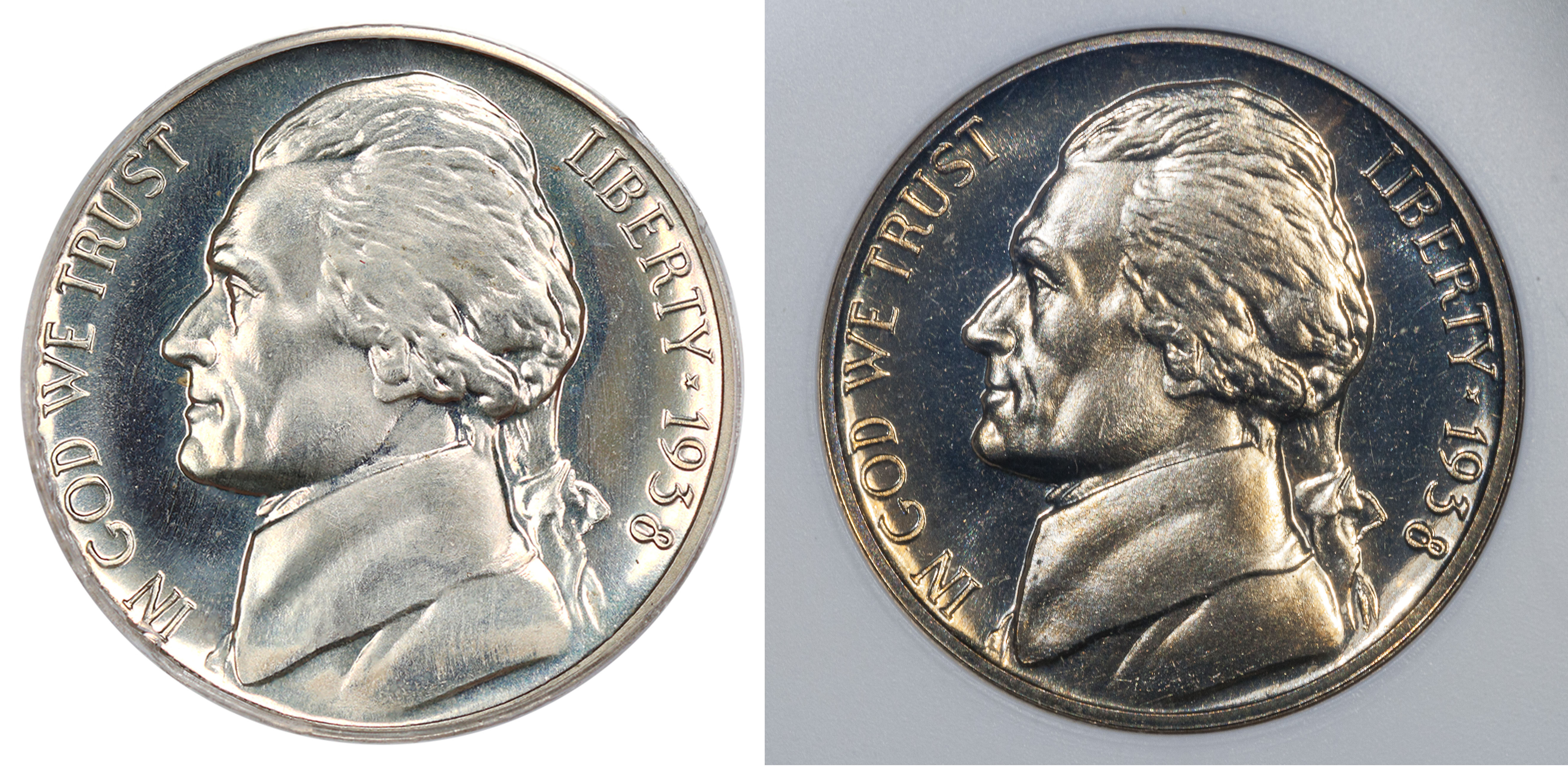
A video of the above genuine proof (one is under a loupe and was the subject of a different thread of mine):
https://www.youtube.com/shorts/VTaTeCwjzSA
https://www.youtube.com/shorts/0OKomroUKhQ
Therefore, I have concluded that this coin has been altered. I highly suggest that this coin be presented to PCGS and that PCGS honor their guarantee with this coin and remove it from the market. If one remains in doubt, a simple test can be performed by PCGS to confirm authenticity. If the coin is put through the PCGS conservation process for putty, I would expect this “frost” to fade away and dissolve."
Had this proof been sent to CAC, it's likely it would have been weeded out a bit sooner. Luckily, it was caught before another unsuspecting buyer purchased a very expensive mislabeled coin.
Of course, experience cannot be beat. But if you don't have the experience, perhaps ask someone who does.
This is a very very rare coin (1 of 3 in existence), in this holder. Unfortunately, it's an altered proof, and has had the "cameo" applied to it's surfaces.



Here's the real story behind the coin. This coin was certified in the early 2000s, and was suspected a little bit around that time until 2005 or so when it disappeared. No one said much to anyone about it, just some minor grumblings.
This is exactly my kind of coin, and one I have years of experience with. To me, this coin just looks wrong, and if you know what to look for, you'll see why. When I saw it, I noticed almost immediately something was off, and I did a few mental checks. Sure enough, everything added up for an altered proof (and then I did some research to prove it). I immediately got in contact with the auction company and provided them with my evidence and suggested they remove the coin from auction and send it to PCGS. They went though the process of getting an appearance review done with PCGS. We won that appearance review today.
Today, if you looked up the cert number for that 1938 CAM nickel you'd get the following result:
PR GENUINE - UNC Details (94- Altered Surf.).
Here's my detailed analysis of the coin:
"This is an in depth analysis of why I believe the following 1938 PCGS PR67CAM nickel (cert # 40047031) is in fact an altered coin. There are four main points to focus on for this coin, and all are very concerning. Each one of these points relates to why I believe that this coin has had an artificial frost applied to the devices of the coin, likely a putty of some sort. This creates a hard to identify and somewhat realistic alteration that can fool all but those who know what to look for. For a brief background, this alteration is done when a coin doctor takes a brilliant proof and applies a putty or other substance to the devices of the coin, leaving the mirrored fields untouched. This creates the visual appearance of a cameo proof without the coin actually being a cameo proof. Many of these coins got past PCGS in the early 2000s, and this appears to be one such coin.
The first point relates to what I call “die matching.” This is an excellent way to confirm the authenticity of a cameo proof from this era, as it can confirm placement of the frost and the amount of contrast. This is done by comparing the present coin to known other cameo proofs or near cameo proofs from auction listings or CoinFacts. This is the only case I have come across where the coin cannot be matched to another cameo proof or near cameo proof. This is because no other coin from this die pair shows noticeable cameo contrast. This is especially strange because the “frost” is especially high quality on this coin and one would expect more than a few proofs showing noticeable contrast from the same dies to pop up. However, this is not the case. All other cameo proofs and near cameo proofs come back to a different die pair than this coin - the FS-402/unknown reverse pair. This coin is from the FS-403/unknown reverse pair and is the only known contrasted coin from this pair. All other coins from this die pair show brilliant devices. This strongly suggests that this coin is most likely altered, and this is exactly what I would expect for this type of alteration. A coin doctor would take a cheap brilliant proof and turn it into a “cameo,” pocketing the substantial profit off of an unknowing collector.
The second point relates to interesting “frost” placement. When viewing genuine cameo examples from this era, one quickly notices that the high points have the most frost, and the points of relief closest to the field are the areas with the least frost. This is due to the die production process - when new dies were produced they retained their satin frost from the hubbing and acid cleanup process. This was only removed when dies were polished or worn down during striking. The polishing process usually wore away the low point satin frost detail, and in many cases the high point detail as well. In some rare cases, however, the majority of frost was not worn away. This resulted in a cameo proof. These coins often show strongly frosted high point detail, and lightly frosted or brilliant low point detail from where the die was polished - again, the low point detail being closest to the fields was the first detail to be removed. On this coin, we see the opposite effect taking place - the high point detail lacks “frost” (Jefferson’s jawline and some of Monticello’s walls), but the low points show “frost” (Jefferson’s hair and the walls closest to the fields). These areas lacking “frost” seem to strongly correlate to where a brush could not reach, rather than where a die would be polished during die production. In addition, dies generally wore their frost away evenly during the striking process, conforming to the average surface of the planchets used. This produced an even loss of the original satin surface of the dies, creating an even wear pattern of the cameo surface.
The die wear was never splotchy or spotted as we see on this coin (see images of reverse splotches which are circled as high point brilliance), which again points to this coin being altered.


The third point relates to the brilliant brush lines observed on the reverse. These lines do not appear on any other proof that I have seen, and there is no logical way this was created at the mint. There was no process of brushing the dies with acid (they were dipped), and there was no post strike treatment for finished pieces. I believe the only explanation for this phenomenon is that the coin is altered. In addition, this is the most obvious and indicative feature of an applied frost alteration.

The last point relates to the overall look of the coin. This is the most subjective opinion of this analysis and is the least based on fact. However, in my experience, the frost on 1936-42 cameo coins is very distinct. It has a rough texture with slight areas of brilliance visible under high magnification. This is due to the frost being created by millions of minute die depressions during the final cleanup and acid dipping of a die before polish. In contrast, when viewing this coin it becomes readily apparent that the “frost” is not at all textured and it appears quite smooth. It has an odd color and sheen, and the overall look of the coin is not at all similar to any other cameo proof of the era. It shows a surface that one would expect if a smooth putty was applied rather than having been caused by a new die with the unworn acid dipped textured frost. Again, the only logical explanation is that the proof has been altered. Below is a comparison of a genuine 1938 contrasted nickel (right) and the altered coin (left). Note the obvious difference in frost texture and color.

A video of the above genuine proof (one is under a loupe and was the subject of a different thread of mine):
https://www.youtube.com/shorts/VTaTeCwjzSA
https://www.youtube.com/shorts/0OKomroUKhQ
Therefore, I have concluded that this coin has been altered. I highly suggest that this coin be presented to PCGS and that PCGS honor their guarantee with this coin and remove it from the market. If one remains in doubt, a simple test can be performed by PCGS to confirm authenticity. If the coin is put through the PCGS conservation process for putty, I would expect this “frost” to fade away and dissolve."
Had this proof been sent to CAC, it's likely it would have been weeded out a bit sooner. Luckily, it was caught before another unsuspecting buyer purchased a very expensive mislabeled coin.
Of course, experience cannot be beat. But if you don't have the experience, perhaps ask someone who does.


Comments
Your body of knowledge is remarkable. You’re quite a Positive asset to our wonderful hobby.
Thanks.
Steve
Just in case someone is not aware, and since I don’t have my YN signature line over here, Steve’s first paragraph is a joke.
I hope @JACAC and @CAC_Team recognize how fortunate this forum is to have a collector with such knowledge and talent as a participant!
Separately, I’m sure that East Coast auction firm that chose to pull the coin based on the information you provided is also very appreciative (and VERY impressed too).
Steve
When I see a young man present himself as @FlyingAl consistently does, it makes me more optimistic about the future of our hobby.
I expect they will hear from PCGS soon. Effectively, a $9k coin became worthless (maybe $20 max in an altered holder).
JK
Steve
JK
Oh no, now you've got me thinking....
A series would be fun for sure. I'll give it some thought for sure.
I am sure most of us would also contribute...